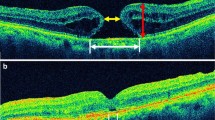Abstract
Purpose
To determine the association between choroidal thickness (CT) and anatomic success in closed and open macular holes (MHs) following surgery.
Methods
One hundred and thirty-six eyes of 136 patients who underwent surgery due to primary MH were included in this study. Choroidal thickness was measured from various points (subfoveal, temporal, nasal, superior and inferior 1500 µm from the center of the fovea) in both eyes with MH and fellow eyes. We determined associations among the duration of symptoms, MH dimensions and CTs from various points with anatomic success and correlations between CT and MH dimensions and duration of symptoms.
Results
Choroidal thickness was significantly lower in eyes with MH than fellow eyes in both open and closed MHs. Base diameter [p = 0.025, odds ratio (OR) = 0.428], minimum hole diameter (p = 0.030, OR = 0.211) and duration of symptoms [p = 0.034, OR = 0.443] were significantly associated with anatomic success. However, CTs from various points were not associated with anatomic success despite a significant preoperative subfoveal CT difference between open and closed MHs (198 ± 21 µm in open MHs and 230 ± 30 µm in closed MHs; p < 0.001). Preoperative subfoveal CT was moderately correlated with base diameter (r = − 0.505, p < 0.001), minimum hole diameter (r = − 0.518, p < 0.001) and duration of symptoms (r = − 0.510, p < 0.001).
Conclusions
Failed MHs were associated with larger hole dimensions (base diameter and minimum hole diameter) and longer duration of symptoms. Preoperative subfoveal CT was thinner in open MHs, but there was no association with anatomic success. Choroidal thinning may be linked to larger and chronic MHs.


Similar content being viewed by others
References
Gass JD (1995) Reappraisal of biomicroscopic classification of stages of development of a macular hole. Am J Ophthalmol 119(6):752–759
Altaweel M, Ip M (2003) Macular hole: improved understanding of pathogenesis, staging, and management based on optical coherence tomography. Semin Ophthalmol 18:58–66
Wendel RT, Patel AC, Kelly NE, Salzano TC, Wells JW, Novack GD (1993) Vitreous surgery for macular holes. Ophthalmology 100(11):1671–1676
Haritoglou C, Gass CA, Schaumberger M, Gandorfer A, Ulbig MW, Kampik A (2002) Long-term follow-up after macular hole surgery with internal limiting membrane peeling. Am J Ophthalmo 134(5):661–666
Gordon LW, Glaser BM, Ie D, Thompson JT, Sjaarda RN (1995) Full-thickness macular hole formation in eyes with a pre-existing complete posterior vitreous detachment. Ophthalmology 102:1702–1705
Lee SH, Park KH, Kim JH, Heo JW, Yu HG, Yu YS et al (2010) Secondary macular hole formation after vitrectomy. Retina 30:1072–1077
Aras C, Ocakoglu O, Akova N (2004) Foveolar choroidal blood flow in idiopathic macular hole. Int Ophthalmol 25:225–231
Zhang P, Zhou M, Wu Y, Lu B, Li T, Zhao J et al (2017) Choroidalthickness inunilateal idiopathic macular hole: a cross-sectional study and meta-analysis. Retina 37(1):60–69
Willis AW, Garcia-Cosio JF (1996) Macular hole surgery: comparison of longstanding versus recent macular holes. Ophthalmology 103:1811–1814
Ip MS, Baker BJ, Duker JS, Reichel E, Baumal CR, Gangnon R et al (2002) Anatomical outcomes of surgery for idiopathic macular hole as determined by optical coherence tomography. Arch Ophthalmol 120(1):29–35
Wakely L, Rahman R, Stephenson JA (2012) Comparison of several methods of macular hole measurement using optical coherence tomography, and their value in predicting anatomical and visual outcomes. Br J Ophthalmol 96(7):1003–1007
Ullrich S, Haritoglou C, Gass C, Schaumberger M, Mw Ulbig, Kampik A et al (2002) Macular hole size as a prognostic factor in macular hole surgery. Br J Ophthalmol 86:390–393
Kusuhara S, Teraoka Escano MF, Fujii S, Nakanishi Y, Tamura Y, Nagai A et al (2004) Prediction of postoperative visual outcome based on hole configuration by optical coherence tomography in eyes with idiopathic macular holes. Am J Ophthalmol 138:709–716
Ruiz-Moreno JM, Staicu C, Pinero DP, Montero J, Lugo F, Amat P (2008) Optical coherence tomography predictive factors for macular hole surgery outcome. Br J Ophthalmol 92:640–644
Flügel C, Tamm ER, Mayer B, Lutjen-Drecoll E (1994) Species differences in choroidal vasodilative innervation: evidence for specific intrinsic nitrergic and VIP-positive neurons in the human eye. Investig Ophthalmol Vis Sci 35:592–599
Xu LT, Srivastava SK, Ehlers JP, Kaiser PK (2015) Choroidal thickness in macular holes: a case-control study. Ophthalmic Surg Lasers Imaging Retina 46(1):33–37
Reibaldi M, Boscia F, Avitabile T, Uva MG, Russo V, Zagari M et al (2011) Enhanced depth imaging optical coherence tomography of the choroid in idiopathic macular hole: a cross-sectional prospective study. Am J Ophthalmol 151(1):112–117
Zeng J, Li J, Liu R, Chen X, Pan J, Tang S et al (2012) Choroidal thickness in both eyes of patients with unilateral idiopathic macular hole. Ophthalmology 119:2328–2333
Michalewska Z, Michalewski J, Nawrocka Z, Dulczewska-Cichecka K, Nawrocki J (2015) The outer choroidoscleral boundary in full-thickness macular holes before and after surgery—a swept-source OCT study. Graefes Arch Clin Exp Ophthalmol 253:2087–2093
Rawji MH, Flanagan JG (2001) Intraocular and interocular symmetry in normal retinal capillary perfusion. J Glaucoma 10:4–12
Teng Y, Yu M, Wang Y, Liu X, You Q, Liu W (2017) OCT angiography quantifying choriocapillary circulation in idiopathic macular hole before and after surgery. Graefes Arch Clin Exp Ophthalmol 255(5):893–902
Allen RD, Brown J, Zwick H (2004) Laser-induced macular holes demonstrate impaired choroidal perfusion. Retina 24:92–97
Author information
Authors and Affiliations
Corresponding author
Ethics declarations
Conflict of interest
The authors declare that they have no conflict of interest.
Additional information
Publisher's Note
Springer Nature remains neutral with regard to jurisdictional claims in published maps and institutional affiliations.
Rights and permissions
About this article
Cite this article
Sul, S., Gurelik, G., Korkmaz, Ş. et al. Choroidal thickness in macular holes. Int Ophthalmol 39, 2595–2601 (2019). https://doi.org/10.1007/s10792-019-01108-6
Received:
Accepted:
Published:
Issue Date:
DOI: https://doi.org/10.1007/s10792-019-01108-6




